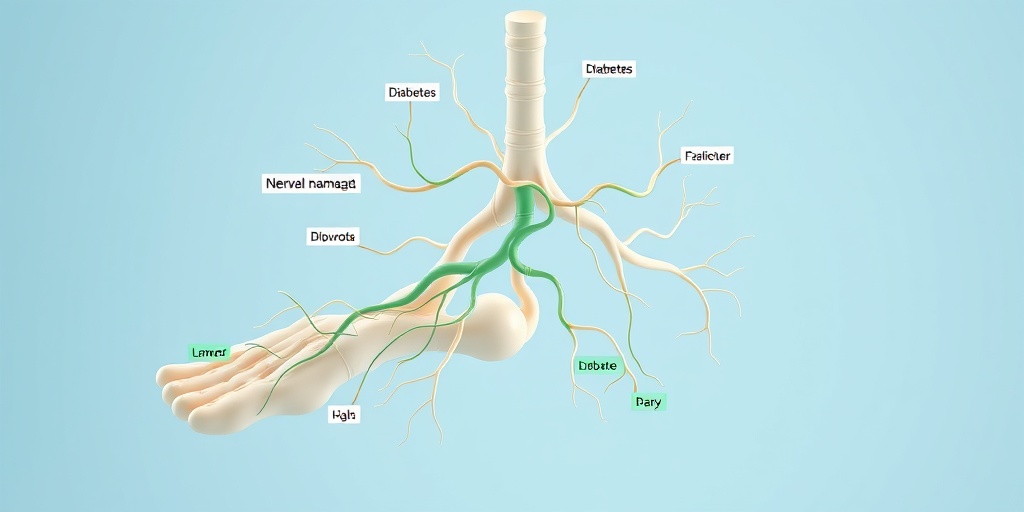What Is Diabetic Neuropathy?
Diabetic neuropathy is a type of nerve damage that can occur in individuals with diabetes. It is a common complication of diabetes, affecting nearly 50% of people who have the condition. This nerve damage can lead to a variety of symptoms, which can significantly impact a person’s quality of life.
Essentially, diabetic neuropathy occurs when high blood sugar levels damage the nerves throughout the body. This damage can affect various types of nerves, including those responsible for sensation, movement, and autonomic functions (like digestion and heart rate). The condition can develop gradually, often going unnoticed until it becomes severe.
Types of Diabetic Neuropathy
There are several types of diabetic neuropathy, each affecting different nerves:
- Peripheral Neuropathy: This is the most common form, affecting the feet and hands. It can cause pain, tingling, and numbness.
- Autonomic Neuropathy: This affects the autonomic nervous system, which controls involuntary bodily functions such as heart rate and digestion.
- Proximal Neuropathy: This type affects the thighs, hips, or buttocks, leading to weakness and pain.
- Focal Neuropathy: This involves sudden weakness or pain in specific areas, such as the eyes or face.
Understanding the type of diabetic neuropathy is crucial for effective treatment and management. If you suspect you have symptoms, consulting a healthcare professional is essential.
Diabetic Neuropathy Symptoms
The symptoms of diabetic neuropathy can vary widely depending on the type of nerves affected. Here are some common symptoms to watch for:
Symptoms in the Feet
Many individuals first notice symptoms of diabetic neuropathy in their feet. These can include:
- Tingling or Numbness: A common early sign, often described as a “pins and needles” sensation.
- Burning Pain: Some people experience a burning sensation, which can be quite uncomfortable.
- Loss of Sensation: In severe cases, individuals may lose the ability to feel pain, temperature, or touch in their feet.
- Foot Ulcers: Due to reduced sensation, injuries may go unnoticed, leading to ulcers and infections.
Symptoms in the Hands
Diabetic neuropathy can also affect the hands, leading to symptoms such as:
- Weakness: Difficulty gripping objects or performing fine motor tasks.
- Tingling or Numbness: Similar to symptoms in the feet, these sensations can occur in the fingers and hands.
- Burning Sensation: Some individuals report a burning feeling in their hands.
Autonomic Symptoms
When autonomic nerves are affected, symptoms may include:
- Digestive Issues: Nerve damage can lead to problems like gastroparesis, causing nausea and bloating.
- Heart Rate Changes: Individuals may experience an abnormal heart rate or blood pressure fluctuations.
- Sexual Dysfunction: This can affect both men and women, leading to difficulties in sexual performance.
When to Seek Help
If you experience any of these symptoms, it’s crucial to consult a healthcare provider. Early diagnosis and management can help prevent further nerve damage and improve your quality of life. Diabetic neuropathy treatment options are available, ranging from lifestyle changes to medications.
For more information on managing diabetic neuropathy and finding evidence-based health answers, consider visiting Yesil Health AI. They provide valuable resources to help you navigate your health journey.
In conclusion, understanding diabetic neuropathy and its symptoms is vital for anyone living with diabetes. By staying informed and proactive, you can take steps to manage this condition effectively. Remember, you are not alone in this journey! 🌟

Types of Diabetic Neuropathy
Diabetic neuropathy is a common complication of diabetes that affects the nerves throughout the body. Understanding the different types of diabetic neuropathy is crucial for effective management and treatment. Here, we’ll explore the main types of diabetic neuropathy, their symptoms, and how they can impact daily life.
1. Peripheral Neuropathy
Peripheral neuropathy is the most prevalent form of diabetic neuropathy. It primarily affects the nerves in the feet and hands, leading to a range of symptoms. Individuals may experience:
- Numbness or tingling in the extremities
- Sharp, burning pain that can be debilitating
- Increased sensitivity to touch
- Weakness in the muscles
This type of neuropathy can significantly impact mobility and quality of life, making it essential to recognize and address symptoms early.
2. Autonomic Neuropathy
Autonomic neuropathy affects the nerves that control involuntary bodily functions, such as heart rate, digestion, and bladder control. Symptoms may include:
- Digestive issues like gastroparesis, which can cause nausea and bloating
- Heart rate abnormalities, leading to dizziness or fainting
- Bladder dysfunction, resulting in urinary incontinence or retention
This type of neuropathy can lead to serious complications if not managed properly, as it affects essential bodily functions.
3. Focal Neuropathy
Focal neuropathy is less common but can occur suddenly, affecting specific nerves, often in the head, torso, or leg. Symptoms may include:
- Sudden weakness or pain in one side of the body
- Double vision or difficulty focusing
- Severe pain in the lower back or pelvis
Focal neuropathy can be alarming due to its sudden onset, but it often resolves on its own over time.
4. Proximal Neuropathy
Proximal neuropathy, also known as diabetic amyotrophy, primarily affects the thighs, hips, and buttocks. Symptoms may include:
- Severe pain in the hip or thigh
- Weakness in the legs
- Difficulty standing up from a sitting position
This type of neuropathy can significantly impact mobility and may require physical therapy for recovery.
Causes of Diabetic Neuropathy
Understanding the causes of diabetic neuropathy is essential for prevention and management. The primary cause is prolonged high blood sugar levels, which can damage nerves over time. Here are some key factors contributing to the development of diabetic neuropathy:
1. High Blood Sugar Levels
Chronic hyperglycemia (high blood sugar) is the leading cause of nerve damage in individuals with diabetes. Over time, elevated glucose levels can lead to:
- Metabolic changes that affect nerve function
- Inflammation that damages nerve fibers
- Reduced blood flow to the nerves, leading to ischemia
Maintaining blood sugar levels within the target range is crucial for preventing diabetic neuropathy.
2. Duration of Diabetes
The longer a person has diabetes, the greater the risk of developing diabetic neuropathy. Studies show that:
- About 50% of individuals with diabetes for over 25 years may develop some form of neuropathy.
- Early diagnosis and management can significantly reduce the risk of complications.
3. Other Health Conditions
Several other health conditions can exacerbate the risk of diabetic neuropathy, including:
- Hypertension (high blood pressure)
- High cholesterol levels
- Obesity, which can lead to insulin resistance
Managing these conditions is vital for reducing the risk of nerve damage.
4. Lifestyle Factors
Unhealthy lifestyle choices can also contribute to the development of diabetic neuropathy. Factors include:
- Smoking, which can impair circulation
- Excessive alcohol consumption, leading to nerve damage
- Poor diet, lacking essential nutrients
Adopting a healthier lifestyle can help mitigate these risks and improve overall health.
In summary, understanding the types and causes of diabetic neuropathy is crucial for effective management and prevention. By recognizing symptoms early and maintaining a healthy lifestyle, individuals can significantly reduce their risk of developing this debilitating condition. 🌟

Risk Factors for Diabetic Neuropathy
Diabetic neuropathy is a common complication of diabetes that affects the nerves, leading to various symptoms such as pain, tingling, and numbness. Understanding the risk factors associated with this condition is crucial for prevention and early intervention. Here are some of the primary risk factors:
1. Duration of Diabetes
The longer a person has diabetes, the higher the risk of developing diabetic neuropathy. Studies show that nearly 50% of individuals with diabetes for over 25 years may experience some form of nerve damage. Regular monitoring and management of blood sugar levels can help mitigate this risk.
2. Poor Blood Sugar Control
Maintaining stable blood glucose levels is essential. High blood sugar can damage nerves over time. Individuals with consistently elevated HbA1c levels are at a greater risk. Effective diabetes management, including diet, exercise, and medication, plays a vital role in reducing this risk.
3. High Blood Pressure
Hypertension can exacerbate nerve damage. People with diabetes often have coexisting high blood pressure, which can lead to a higher incidence of diabetic neuropathy. Regular check-ups and lifestyle changes can help manage both conditions effectively.
4. High Cholesterol Levels
Elevated cholesterol levels can contribute to nerve damage. Cholesterol management through diet, exercise, and medication is crucial for individuals with diabetes to lower their risk of neuropathy.
5. Smoking
Smoking is a significant risk factor for many health issues, including diabetic neuropathy. It can impair blood circulation, leading to reduced oxygen supply to nerves. Quitting smoking can significantly improve overall health and reduce the risk of complications.
6. Obesity
Excess weight can increase the risk of developing type 2 diabetes and its complications, including neuropathy. Maintaining a healthy weight through a balanced diet and regular physical activity is essential for prevention.
7. Age
As individuals age, the risk of developing diabetic neuropathy increases. Older adults with diabetes are particularly vulnerable due to the cumulative effects of long-term high blood sugar levels and other health conditions.
8. Family History
A family history of diabetes or neuropathy can increase an individual’s risk. Genetic factors may play a role in how the body responds to high blood sugar levels, making it essential for those with a family history to be vigilant about their health.
Diagnosis of Diabetic Neuropathy
Diagnosing diabetic neuropathy involves a combination of clinical evaluations, patient history, and specific tests. Early diagnosis is crucial for effective management and prevention of further nerve damage. Here’s how healthcare professionals typically diagnose this condition:
1. Medical History Review
The first step in diagnosing diabetic neuropathy is a thorough review of the patient’s medical history. This includes:
- Duration of diabetes
- Blood sugar control history
- Presence of symptoms such as pain, tingling, or numbness
2. Physical Examination
A comprehensive physical examination is essential. Healthcare providers will assess:
- Reflexes
- Sensation in the feet and hands
- Muscle strength and tone
These assessments help determine the extent of nerve damage and identify any areas of concern.
3. Neurological Tests
Specific tests may be conducted to evaluate nerve function, including:
- Monofilament test: A thin filament is used to test sensation in the feet.
- Tuning fork test: This assesses vibration sensation.
- Nerve conduction studies: These measure how fast electrical signals move through the nerves.
4. Blood Tests
Blood tests may be performed to check for:
- Blood sugar levels
- Cholesterol levels
- Vitamin deficiencies
These tests help rule out other potential causes of neuropathy and assess overall health.
5. Imaging Studies
In some cases, imaging studies such as MRI or ultrasound may be used to visualize the nerves and surrounding tissues. This can help identify any structural issues contributing to nerve damage.
Early diagnosis and intervention are key to managing diabetic neuropathy effectively. If you experience any symptoms or have risk factors, consult your healthcare provider for a comprehensive evaluation. 🩺

Diabetic Neuropathy Treatment Options
Diabetic neuropathy is a common complication of diabetes that affects the nerves, leading to symptoms such as pain, tingling, and numbness, particularly in the feet and hands. Understanding the various treatment options available can empower individuals to manage their symptoms effectively and improve their quality of life.
Medications for Diabetic Neuropathy
Several medications can help alleviate the symptoms of diabetic neuropathy. These include:
- Antidepressants: Certain antidepressants, such as amitriptyline and duloxetine, can help relieve nerve pain.
- Anticonvulsants: Medications like gabapentin and pregabalin are often prescribed to reduce nerve pain.
- Topical Treatments: Creams containing capsaicin or lidocaine can be applied directly to the skin to relieve localized pain.
Physical Therapy and Rehabilitation
Engaging in physical therapy can be beneficial for individuals with diabetic neuropathy. A physical therapist can design a personalized exercise program that focuses on:
- Improving Strength: Strengthening exercises can help improve muscle function and reduce the risk of falls.
- Enhancing Balance: Balance training can help prevent injuries and improve mobility.
- Increasing Flexibility: Stretching exercises can alleviate stiffness and improve overall movement.
Alternative Therapies
Some individuals find relief through alternative therapies, which may include:
- Acupuncture: This traditional Chinese medicine technique may help reduce pain and improve nerve function.
- Massage Therapy: Therapeutic massage can promote relaxation and improve circulation, potentially alleviating symptoms.
- Dietary Supplements: Supplements like alpha-lipoic acid and vitamin B12 may support nerve health, but it’s essential to consult a healthcare provider before starting any new supplement.
Managing Blood Sugar Levels
One of the most crucial aspects of managing diabetic neuropathy is maintaining optimal blood sugar levels. High blood sugar can exacerbate nerve damage, so it’s vital to:
- Monitor Blood Glucose: Regularly check blood sugar levels to ensure they remain within the target range.
- Follow a Balanced Diet: A diet rich in whole grains, lean proteins, healthy fats, and plenty of fruits and vegetables can help stabilize blood sugar levels.
- Stay Active: Regular physical activity can improve insulin sensitivity and help control blood sugar levels.
Managing Diabetic Neuropathy at Home
Living with diabetic neuropathy can be challenging, but there are several strategies you can implement at home to manage your symptoms effectively. Here are some practical tips:
Foot Care
Proper foot care is essential for individuals with diabetic neuropathy, as nerve damage can lead to decreased sensation and increase the risk of injuries. Consider the following:
- Daily Inspections: Check your feet daily for cuts, blisters, or any signs of infection.
- Proper Footwear: Wear well-fitting shoes that provide adequate support and cushioning.
- Moisturize: Keep your feet moisturized to prevent dry skin and cracking, but avoid applying lotion between the toes.
Pain Management Techniques
Managing pain at home can involve various techniques, including:
- Heat and Cold Therapy: Applying heat or cold packs can help alleviate pain and discomfort.
- Relaxation Techniques: Practices such as yoga, meditation, or deep breathing can help reduce stress and improve overall well-being.
- Regular Exercise: Engaging in low-impact exercises like walking, swimming, or cycling can help improve circulation and reduce pain.
Healthy Lifestyle Choices
Adopting a healthy lifestyle can significantly impact the management of diabetic neuropathy. Focus on:
- Balanced Nutrition: A diet low in refined sugars and high in fiber can help maintain stable blood sugar levels.
- Adequate Hydration: Staying hydrated is essential for overall health and can help alleviate some symptoms.
- Avoiding Alcohol and Smoking: Both can worsen nerve damage and should be minimized or eliminated.
By implementing these strategies and working closely with healthcare professionals, individuals with diabetic neuropathy can take control of their condition and lead fulfilling lives. Remember, early intervention and consistent management are key to minimizing the impact of this condition. 🌟

Frequently Asked Questions about Diabetic Neuropathy
What is Diabetic Neuropathy?
Diabetic neuropathy is a type of nerve damage that can occur in individuals with diabetes. It is caused by prolonged high blood sugar levels, which can harm the nerves throughout the body, particularly in the feet and hands.
What are the symptoms of Diabetic Neuropathy?
Common symptoms of diabetic neuropathy include:
- Numbness or tingling in the feet and hands
- Sharp, burning pain
- Increased sensitivity to touch
- Muscle weakness
- Loss of coordination
How is Diabetic Neuropathy diagnosed?
Diagnosis typically involves a physical examination, a review of medical history, and tests such as:
- Nerve conduction studies
- Electromyography (EMG)
- Blood tests to check glucose levels
What are the treatment options for Diabetic Neuropathy?
Treatment for diabetic neuropathy focuses on managing symptoms and may include:
- Medications such as pain relievers, antidepressants, or anticonvulsants
- Physical therapy to improve strength and coordination
- Dietary changes and blood sugar management
- Topical treatments like creams or patches
Can Diabetic Neuropathy be treated at home?
Yes, there are several home remedies and lifestyle changes that can help manage diabetic neuropathy symptoms:
- Regular exercise to improve blood circulation
- Maintaining a healthy diet low in sugar and carbohydrates
- Using foot care products to keep feet healthy
- Practicing stress management techniques
What is the ICD-10 code for Diabetic Neuropathy?
The ICD-10 code for diabetic neuropathy is E11.40, which refers to diabetic neuropathy in uncontrolled diabetes. There are specific codes for different types of neuropathy, so it’s essential to consult a healthcare provider for accurate coding.
What does Diabetic Neuropathy feel like?
Individuals with diabetic neuropathy often describe sensations such as tingling, burning, or a feeling of pins and needles in their extremities. Some may experience severe pain or discomfort, while others may have numbness that can lead to injuries.
Is there hope for recovery from Diabetic Neuropathy?
While diabetic neuropathy can be a chronic condition, many individuals find relief through proper management of diabetes, lifestyle changes, and medical treatments. Early intervention is key to preventing further nerve damage.
Can dietary changes help with Diabetic Neuropathy?
Yes, a balanced diet that stabilizes blood sugar levels can significantly impact the management of diabetic neuropathy. Foods rich in antioxidants, omega-3 fatty acids, and vitamins can support nerve health.
Are there any new treatments for Diabetic Neuropathy?
Research is ongoing, and new treatments are continually being explored. Some studies are investigating the effects of supplements like N-acetyl cysteine and other medications that may provide relief for those suffering from diabetic neuropathy.




